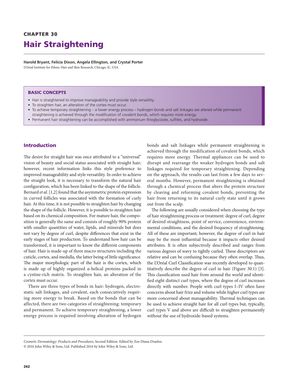TLDR Hair straightening changes hair structure and can cause damage if done wrong, but improvements in the methods are expected to continue.
The document from 2015 discusses the methods of hair straightening, which involves altering the hair's cortex. Temporary straightening changes hydrogen bonds and salt linkages, while permanent straightening modifies covalent bonds using chemicals like ammonium thioglycolate, sulfites, and hydroxides. The treatments are popular for their ability to provide style versatility and manageability, but there is a risk of overprocessing if done incorrectly. The document suggests that future improvements in hair straightening technology will continue to be made, but the use of heat and chemicals will likely persist. It emphasizes the importance of understanding the benefits, drawbacks, and correct application of each method to minimize potential damage, tailored to individual style preferences and hair characteristics.
95 citations
,
January 2007 in “Human biology” Human hair can be classified into eight types based on physical features, not ethnicity.
 115 citations
,
September 2005 in “International Journal of Dermatology”
115 citations
,
September 2005 in “International Journal of Dermatology” Different ethnic groups have unique hair growth patterns, with African hair growing slower and less dense, Asian hair growing fast but sparse, and Caucasian hair being densest; men are more likely to experience hair loss than women.
10 citations
,
January 1994 Hair can be straightened using different chemicals, not just strong alkali.
9 citations
,
January 1981 Nucleophilic reagents break down hair keratin, forming more lanthionine and lysinoalanine than in wool.
 March 2010 in “Cosmetic Dermatology”
March 2010 in “Cosmetic Dermatology” Hair straightening methods have advanced to improve effectiveness and reduce damage, but still rely on heat and chemicals.
2 citations
,
January 2022 in “Anais brasileiros de dermatologia/Anais Brasileiros de Dermatologia” Chemical hair straighteners can cause scalp and hair damage, but long-term effects are unclear.
53 citations
,
July 2016 in “Cosmetics” Future hair cosmetics will be safer and more effective.
 January 2017 in “Clinical approaches and procedures in cosmetic dermatology”
January 2017 in “Clinical approaches and procedures in cosmetic dermatology” Cosmetic procedures can harm hair, but damage can be minimized with knowledge and care; however, once hair is damaged, it cannot be reliably repaired.
 1 citations
,
January 2017 in “Clinical approaches and procedures in cosmetic dermatology”
1 citations
,
January 2017 in “Clinical approaches and procedures in cosmetic dermatology” Hair can't be reliably repaired once damaged; prevention and proper product use are key to maintaining hair health.




